In the event that you need to realize how to recognize what kind of goldfish you have, you need to see its highlights. Here are some one of a kind highlights that make distinguishing your goldfish basic. There are many kinds of goldfish, numerous that have been cross reproduced which take on a blend of various highlights.
A body shape that has a lengthened straightened football shape include: The Common, the Comet, Shubunkin. (great varieties for an outside goldfish pond).The normal, comet and shubunkin look practically the same fit and shadings.
•The normal doesn't come in calico however the comet and shubunkin do.
•The shubunkin is just calico so if it's calico with short blades, it can't be a typical.
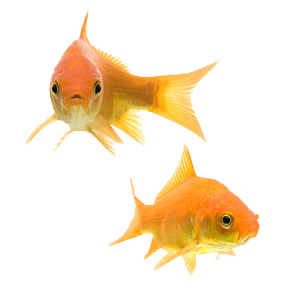
An egg shape body shape are viewed as the extravagant varieties and can include: Fantail, Ryukin, Veiltail, Oranda, Telescope, Black Moor, Panda Butterfly, Ranchu, lionhead, Pompon, Pearlscale, Hama Nishki, Celestial and Bubble-Eye.The develop oranda, ranchu and lionhead has a mole like wen hood cover over its face and head
•The ranchu has a conspicuous curve in its back and descending pointed tail balances.
•The lionhead and oranda have a straighter back line.
•A goldfish with a hood cover with a straight back and no dorsal balance is a lionhead.
•The veiltail has long streaming blades and tail.
•The telescope, dark field and panda butterfly have their eyes on the sides of ball like bulges
•A dark field is a telescope/globe-eye however is just dark or blurred dark in shading.
he panda butterfly looks like the shades of a panda bear, clear segments of highly contrasting.
The pearlscale and hama nishiki have a golf ball body shape with scales that stand apart like minimal white arches
the hama nishiki has a slight hood cover on top of its head while the pearlscale doesn't. The divine has protruding eyes that point up and no dorsal fin.The bubble eye has two air pocket formed check pockets
Bristol Shubunkins
Bubble Eye
Butterfly Tail
Celestial Eye
American Shubunkins
Bristol Shubunkins
Bubble Eye
Butterfly Tail
Celestial Eye
American Shubunkins
Bristol Shubunkins
Bubble Eye
Butterfly Tail
Celestial Eye
Comet
Common
Curled-gill
Eggfish
Fantail
Imperial
Izumo Nankin
Jikin
Lionchu
Lionhead
London Shubunkins
Moor
Nymph
Oranda
Panda Telescope
Pearlscale
Pompom
Ranchu
Red Cap Oranda
Ryukin
Sabao
Shukin
Tamasaba
Telescope
Tosakin
Veiltail
Wakin
Watona
The Common Goldfish
Carassius AuratusAsian in beginning, the normal goldfish is an individual from the Cyprindae fish family. The regular goldfish is identified with the numerous types of carp, koi and different kinds of breeds. The name Auratus in a real sense signifies "overlaid with gold". This types of fish has been raised by people for over 1,000 years and at some point during this period, they turned out to be family pets.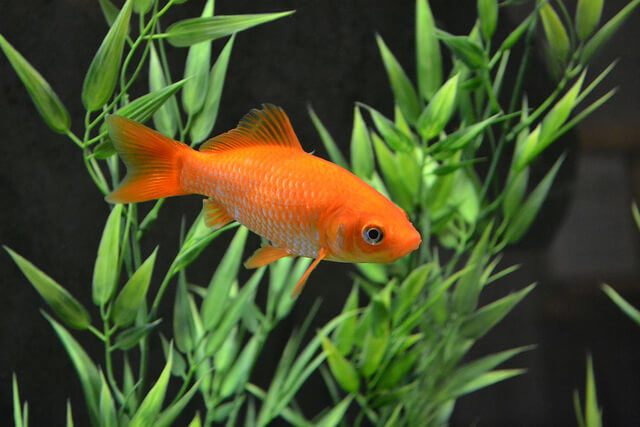 The regular goldfish is an incredible fish for amateurs since it's a solid variety of goldfish. It can live in water with temperatures going from 55-80*F (12-26*C), with a pH of 6-8, which is similar as faucet water. The basic goldfish doesn't need a warmer and needs just insignificant consideration whenever put without help from anyone else in an all around sifted 10-gallon aquarium (38 liters). In the wild, you can track down these in freshwater, lakes, streams, trenches and even trenches that have sufficient vegetation. This water can be sluggish to stale. They do best in cooler water around the low 70s.Goldfish are anyway friendly creatures and would profit with having a tank mate. You can keep two of three little goldfish (a couple of inches or less) in a 10-gallon tank however when they develop, you will probably have to update your tank size. A goldfish that is appropriately focused on can live for above and beyond five years (40 years in addition to max) and develop to around 12 inches in length, 32cm (4 inches normal, 10cm).A little one-gallon goldfish bowl (3.7 liters) isn't strongly suggested. At the point when you place a goldfish in a little space like a bowl, the water gets messy quick and make the goldfish unfortunate. Peruse the following post for novices: goldfish bowl size for more data. On the off chance that space is an issue, consider purchasing an extravagant Beta fish or cold-water minnows which will improve in a little space than a goldfish would.A Beta requirements great water boundary as well however it likewise can breath oxygen through its mouth as well as breathing through its gills. This simply implies they can live in stale water with low oxygen levels far superior to other fish species. Indeed, even with this species, you will in any case have to perform routine support to keep them solid and glad.
The regular goldfish is an incredible fish for amateurs since it's a solid variety of goldfish. It can live in water with temperatures going from 55-80*F (12-26*C), with a pH of 6-8, which is similar as faucet water. The basic goldfish doesn't need a warmer and needs just insignificant consideration whenever put without help from anyone else in an all around sifted 10-gallon aquarium (38 liters). In the wild, you can track down these in freshwater, lakes, streams, trenches and even trenches that have sufficient vegetation. This water can be sluggish to stale. They do best in cooler water around the low 70s.Goldfish are anyway friendly creatures and would profit with having a tank mate. You can keep two of three little goldfish (a couple of inches or less) in a 10-gallon tank however when they develop, you will probably have to update your tank size. A goldfish that is appropriately focused on can live for above and beyond five years (40 years in addition to max) and develop to around 12 inches in length, 32cm (4 inches normal, 10cm).A little one-gallon goldfish bowl (3.7 liters) isn't strongly suggested. At the point when you place a goldfish in a little space like a bowl, the water gets messy quick and make the goldfish unfortunate. Peruse the following post for novices: goldfish bowl size for more data. On the off chance that space is an issue, consider purchasing an extravagant Beta fish or cold-water minnows which will improve in a little space than a goldfish would.A Beta requirements great water boundary as well however it likewise can breath oxygen through its mouth as well as breathing through its gills. This simply implies they can live in stale water with low oxygen levels far superior to other fish species. Indeed, even with this species, you will in any case have to perform routine support to keep them solid and glad.
 The regular goldfish is an incredible fish for amateurs since it's a solid variety of goldfish. It can live in water with temperatures going from 55-80*F (12-26*C), with a pH of 6-8, which is similar as faucet water. The basic goldfish doesn't need a warmer and needs just insignificant consideration whenever put without help from anyone else in an all around sifted 10-gallon aquarium (38 liters). In the wild, you can track down these in freshwater, lakes, streams, trenches and even trenches that have sufficient vegetation. This water can be sluggish to stale. They do best in cooler water around the low 70s.Goldfish are anyway friendly creatures and would profit with having a tank mate. You can keep two of three little goldfish (a couple of inches or less) in a 10-gallon tank however when they develop, you will probably have to update your tank size. A goldfish that is appropriately focused on can live for above and beyond five years (40 years in addition to max) and develop to around 12 inches in length, 32cm (4 inches normal, 10cm).A little one-gallon goldfish bowl (3.7 liters) isn't strongly suggested. At the point when you place a goldfish in a little space like a bowl, the water gets messy quick and make the goldfish unfortunate. Peruse the following post for novices: goldfish bowl size for more data. On the off chance that space is an issue, consider purchasing an extravagant Beta fish or cold-water minnows which will improve in a little space than a goldfish would.A Beta requirements great water boundary as well however it likewise can breath oxygen through its mouth as well as breathing through its gills. This simply implies they can live in stale water with low oxygen levels far superior to other fish species. Indeed, even with this species, you will in any case have to perform routine support to keep them solid and glad.
The regular goldfish is an incredible fish for amateurs since it's a solid variety of goldfish. It can live in water with temperatures going from 55-80*F (12-26*C), with a pH of 6-8, which is similar as faucet water. The basic goldfish doesn't need a warmer and needs just insignificant consideration whenever put without help from anyone else in an all around sifted 10-gallon aquarium (38 liters). In the wild, you can track down these in freshwater, lakes, streams, trenches and even trenches that have sufficient vegetation. This water can be sluggish to stale. They do best in cooler water around the low 70s.Goldfish are anyway friendly creatures and would profit with having a tank mate. You can keep two of three little goldfish (a couple of inches or less) in a 10-gallon tank however when they develop, you will probably have to update your tank size. A goldfish that is appropriately focused on can live for above and beyond five years (40 years in addition to max) and develop to around 12 inches in length, 32cm (4 inches normal, 10cm).A little one-gallon goldfish bowl (3.7 liters) isn't strongly suggested. At the point when you place a goldfish in a little space like a bowl, the water gets messy quick and make the goldfish unfortunate. Peruse the following post for novices: goldfish bowl size for more data. On the off chance that space is an issue, consider purchasing an extravagant Beta fish or cold-water minnows which will improve in a little space than a goldfish would.A Beta requirements great water boundary as well however it likewise can breath oxygen through its mouth as well as breathing through its gills. This simply implies they can live in stale water with low oxygen levels far superior to other fish species. Indeed, even with this species, you will in any case have to perform routine support to keep them solid and glad.Comet
The Comet Goldfish, thought to have begun from the territory of Washington in the last part of the 1800s, comes in a few varieties, the most mainstream being the orange metallic comet whose shading shows well in goldfish lakes. Different varieties arrive in a variety of calicos; calico assortments like the red and silver sarassa comet. Large numbers of the shading mixes come in colors like red and white, dark and orange, yellow, red, dark, and obviously goldfish orange. 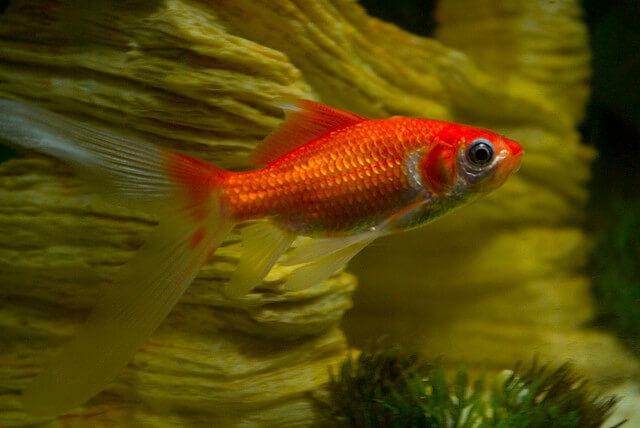 The comet goldfish is like the regular goldfish types and is frequently confused with it, however the comet has a more thin body with more perceptible and extended blades; particularly the caudal balance, which is the greater part to three-quarter the size of its own body. The caudal blade will likewise be significantly more pointed on its finishes contrasted with the regular goldfish. The comet goldfish will likewise have two pectoral balances and pelvic balances; while the dorsal balance, butt-centric blade, and caudal balance will be single.
The comet goldfish is like the regular goldfish types and is frequently confused with it, however the comet has a more thin body with more perceptible and extended blades; particularly the caudal balance, which is the greater part to three-quarter the size of its own body. The caudal blade will likewise be significantly more pointed on its finishes contrasted with the regular goldfish. The comet goldfish will likewise have two pectoral balances and pelvic balances; while the dorsal balance, butt-centric blade, and caudal balance will be single.
Shubunkin
The shubunkin goldfish comes in two assortments (London shubunkin and Bristol shubunkin). Its body looks similar as the normal or comet goldfish, yet its tones take after that of what you would discover in an extravagant goldfish type. It has one caudal tail balance, one dorsal balance, and combined pectoral and pelvic balances. The Bristol is bigger, and its caudal blade is more adjusted than that of the London.
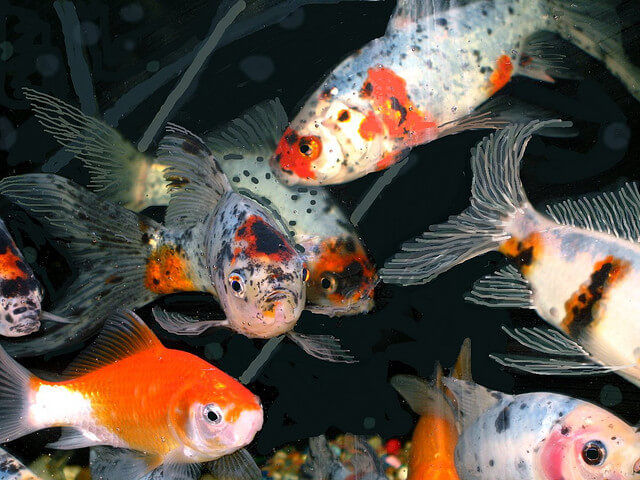 The shade of the shubunkin goldfish ought to be calico. 25% of its tone ought to be a blue-silver shading that goes about as a foundation for its other body tones. An even layer of solid dark spots and shadings that run into the shubunkins blades is the ideal search for show goldfish. Both the London and Bristol assortment is one of the hardier kinds of goldfish. This makes it an ideal goldfish for an outside lake or an indoor goldfish aquarium. On the off chance that you do decide to stock your tank or lake with shubunkins, abstain from blending them in with the sluggish air pocket eyes or divine goldfish. The quicker moving shubunkins will out eat these other goldfish types which could prompt them being famished. Wakin goldfish The wakin goldfish is a well known variety in Japan. It's believed to be the regular goldfish of East Asia. The Wakin goldfish looks like the comet goldfish with a stretched body however has a twofold caudal tail balance similar as the fantail goldfish, just more limited. Just the wakin and jikin goldfish have a prolonged body and twofold butt-centric and caudal blades. The wakin goldfish is a tough variety that is best positioned in a goldfish lake. On the off chance that it's put in a goldfish tank, the tank ought to be adequately enormous to oblige its development of over a foot long (30cm). It is anything but a forceful goldfish breed however is a quick swimmer with a major craving thus the wakin goldfish is anything but a decent tank mate for any lethargic swimming goldfish breeds. the hunger of the wakin goldfish can be an issue if the tank or lake contain live sea-going plants that it finds scrumptious. The most well-known shades of the wakin goldfish are a strong red or a variegated red and white tone. The ideal equilibrium of red and white tones ought to be creamer, yet some goldfish may just contain a couple of little stripes of red on a generally white body; or the other way around. The reds ought to be profound and vivid, incredible for a goldfish lake. Different tones incorporate metallics or variegated: oranges, yellows, earthy colors and blacks.
The shade of the shubunkin goldfish ought to be calico. 25% of its tone ought to be a blue-silver shading that goes about as a foundation for its other body tones. An even layer of solid dark spots and shadings that run into the shubunkins blades is the ideal search for show goldfish. Both the London and Bristol assortment is one of the hardier kinds of goldfish. This makes it an ideal goldfish for an outside lake or an indoor goldfish aquarium. On the off chance that you do decide to stock your tank or lake with shubunkins, abstain from blending them in with the sluggish air pocket eyes or divine goldfish. The quicker moving shubunkins will out eat these other goldfish types which could prompt them being famished. Wakin goldfish The wakin goldfish is a well known variety in Japan. It's believed to be the regular goldfish of East Asia. The Wakin goldfish looks like the comet goldfish with a stretched body however has a twofold caudal tail balance similar as the fantail goldfish, just more limited. Just the wakin and jikin goldfish have a prolonged body and twofold butt-centric and caudal blades. The wakin goldfish is a tough variety that is best positioned in a goldfish lake. On the off chance that it's put in a goldfish tank, the tank ought to be adequately enormous to oblige its development of over a foot long (30cm). It is anything but a forceful goldfish breed however is a quick swimmer with a major craving thus the wakin goldfish is anything but a decent tank mate for any lethargic swimming goldfish breeds. the hunger of the wakin goldfish can be an issue if the tank or lake contain live sea-going plants that it finds scrumptious. The most well-known shades of the wakin goldfish are a strong red or a variegated red and white tone. The ideal equilibrium of red and white tones ought to be creamer, yet some goldfish may just contain a couple of little stripes of red on a generally white body; or the other way around. The reds ought to be profound and vivid, incredible for a goldfish lake. Different tones incorporate metallics or variegated: oranges, yellows, earthy colors and blacks. 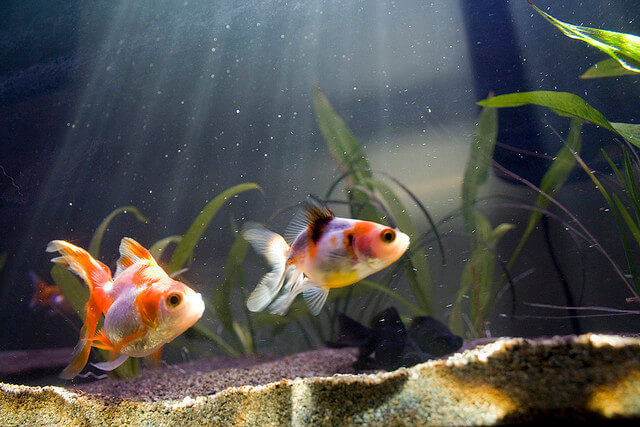
The ryukin goldfish from the Ryukyu Islands is a mainstream goldfish reared in Japan. It seems to be like the fantail goldfish yet stands separated with a noticeable protuberance towards the rear of its head which hoists the dorsal blade. The long caudal tail balances can have three or four projections, with the three-lobed ryukin having what the Japanese call a 'cherry bloom petal tail.' There are a few goldfish sorts of ryukin, the yamagata kingyo, sabao, and tamasaba that have been reproduced to just have a solitary caudal tail balance. Ryukin goldfish arrive in an assortment of shading blends, including: strong tones (self-hued) and numerous tones (variegated) of a dark red, red and white, blue, white, calico and then some. A strong assortment of goldfish, the ryukin can be set in your outside goldfish lake or brought into a goldfish aquarium with other goldfish with no requirement for additional consideration. Great tank mates incorporate the oranda, lionhead, or Ranchu Goldfish. Be cautious that your air pocket eye, and telescope goldfish breeds are not being tormented around by these harder varieties.
Fancy Fantail
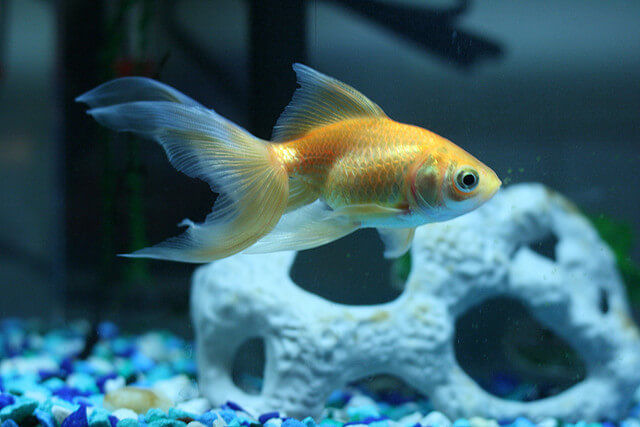 The body of the Fantail Goldfish ought to be around three-fifths of its general length and have an egg shape appearance. The solitary single balance on the fantail goldfish is the dorsal blade; any remaining balances are combined, including the caudal balance which is divided into halves with a forked appearance on each balance. Despite the fantail's balance, all are tough and adjusted toward the finish to take after, what else, edges of a fan. This is most perceptible when seeing the caudal tail blade from straight above.
The body of the Fantail Goldfish ought to be around three-fifths of its general length and have an egg shape appearance. The solitary single balance on the fantail goldfish is the dorsal blade; any remaining balances are combined, including the caudal balance which is divided into halves with a forked appearance on each balance. Despite the fantail's balance, all are tough and adjusted toward the finish to take after, what else, edges of a fan. This is most perceptible when seeing the caudal tail blade from straight above.
Fantail goldfish arrive in a variety of shadings from metallic self-hued (single tone) to a variegated (numerous tones), including calico. The shade of the variegated assortment ought to reach out into the balances and the calico assortment ought to be primarily blue with patches of different shadings. Shades of the fantail goldfish generally arrive in a couple of solids or a blend of orange, blue (silver), dark, bronze and red. A decent quality fantail will have a decent equilibrium of shading on the two sides of its body. While the fantail goldfish is remembered for the extravagant goldfish assortment and regularly reared to look good, they are a strong animal categories and are a fantastic decision for fledglings or for your open air goldfish lake. With the correct consideration, your fantails can live for more than ten to twenty years. At development, the fantail can be six to eight inches in length.
Veiltail
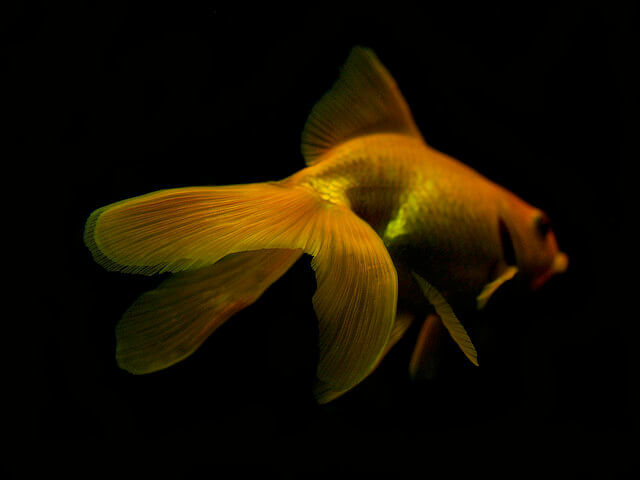 The veiltail goldfish is a well known kind of goldfish among gatherers and specialists however it an assortment that is hard to raise for appearing. It's long streaming combined caudal is the veiltails most conspicuous element. the caudal tail blades ought not be forked or have pointed tips yet be totally separated while seen from a higher place. When your veiltail goldfish swims, the caudal tail blades should stream exquisitely in the water. Its dorsal balance ought not overlay over or droop but instead it should influence like a banner in the breeze. The pectoral and pelvic balances ought to be long and tight. Shading astute, the veiltail goldfish can be metallic self-hued (strong), variegated (numerous tones) or calico in shading. The tones should solid and run into their fins.This goldfish type isn't pretty much as strong as the normal, comet or ryukin goldfish yet it can make due in an open air goldfish lake if the conditions are not very limit. Most goldfish proprietors will decide to put their veiltail goldfish into their indoor aquariums.
The veiltail goldfish is a well known kind of goldfish among gatherers and specialists however it an assortment that is hard to raise for appearing. It's long streaming combined caudal is the veiltails most conspicuous element. the caudal tail blades ought not be forked or have pointed tips yet be totally separated while seen from a higher place. When your veiltail goldfish swims, the caudal tail blades should stream exquisitely in the water. Its dorsal balance ought not overlay over or droop but instead it should influence like a banner in the breeze. The pectoral and pelvic balances ought to be long and tight. Shading astute, the veiltail goldfish can be metallic self-hued (strong), variegated (numerous tones) or calico in shading. The tones should solid and run into their fins.This goldfish type isn't pretty much as strong as the normal, comet or ryukin goldfish yet it can make due in an open air goldfish lake if the conditions are not very limit. Most goldfish proprietors will decide to put their veiltail goldfish into their indoor aquariums.
Globe Eye or Telescope The Telescope Goldfish or globe eye goldfish as it is known in Europe and mythical beast fish in the far east is an extravagant goldfish type. Distending eyes that start to create around a half year old enough obviously clarify the name of this extravagant goldfish breed and make it simple to perceive if a goldfish is a telescope. A great telescope goldfish has great balanced situation of its two eyes, each situated on the furthest tip of its globe formed bulge. The body takes after that of the veiltail goldfish, with a short profound adjusted body. Beside the single dorsal blade, all the telescope goldfish's balances are matched and pointed, including the caudal tail balance. The dorsal blade is high on the back with a somewhat raised appearance like the ryukin goldfish When the telescope goldfish swims, the dorsal balance should strong and upstanding.
Telescope bubble eye goldfish
The completely isolated caudal balances ought to be around 3/4 the length of the body of the telescope and forked about a fourth of the general length of the caudal tail balances. At the point when it swims the caudal tail blade ought to be streaming like the oranda goldfish. The telescope goldfish arrives in an assortment of tones: each of the one tone (self-shaded) of red, blue, chocolate, or white; bi tones (variegated) of dark/white and red/white; and calico. The calico kinds ought to have a blue foundation with a decent even equilibrium of radiant earthy colored, orange, red yellow and violet patches, with little dark spots over its whole body. There is an assortment that is named a panda butterfly telescope since its tones are predominately high contrast and there is additionally the well known broadtail field or dark field goldfish. The telescope goldfish is strong and can get by in cool waters, however it definitely should not be kept in an outside goldfish lake. The primary explanation is that is has helpless vision and can't contend with other goldfish types for food. Another explanation, which likewise has to do with their jutting eyes, is that telescope goldfish eyes are powerless disease and injury. Make it a standard to just place these goldfish among other sluggish or sensitive varieties.
Broadtail Moor
The broadtail moor goldfish or all the more famously known as the dark field, ought to be totally dark (self-hued) all through the body and blades. Be that as it may, as a general rule it contains shades of earthy colored or silver. The shade of a show quality dark field is a level dirty shading.
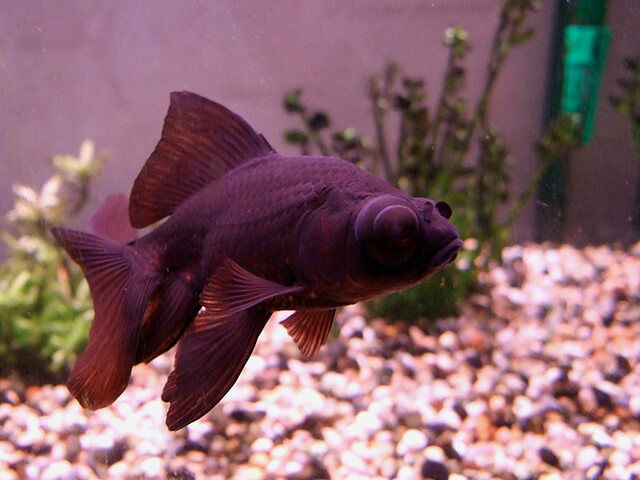 The dark field intently looks like the veiltail goldfish. The single dorsal blade ought to be high on the dark fields back; any remaining balances ought to be matched. The combined and streaming caudal blade ought to be completely isolated with adjusted tips and have a shortfall of a forked appearance. It contrasts from the veiltail goldfish types in that the dark field has jutting eyes that look like the telescope goldfish. A show-quality dark field will have its eye set on the limit tips of its bulges. It's this style of eye that gives the dark field helpless vision and is the explanation you ought to try not to put them into an aquarium with the more deft types of goldfish; they will out-contend the more slow eating dark field goldfish.
The dark field intently looks like the veiltail goldfish. The single dorsal blade ought to be high on the dark fields back; any remaining balances ought to be matched. The combined and streaming caudal blade ought to be completely isolated with adjusted tips and have a shortfall of a forked appearance. It contrasts from the veiltail goldfish types in that the dark field has jutting eyes that look like the telescope goldfish. A show-quality dark field will have its eye set on the limit tips of its bulges. It's this style of eye that gives the dark field helpless vision and is the explanation you ought to try not to put them into an aquarium with the more deft types of goldfish; they will out-contend the more slow eating dark field goldfish.
Oranda
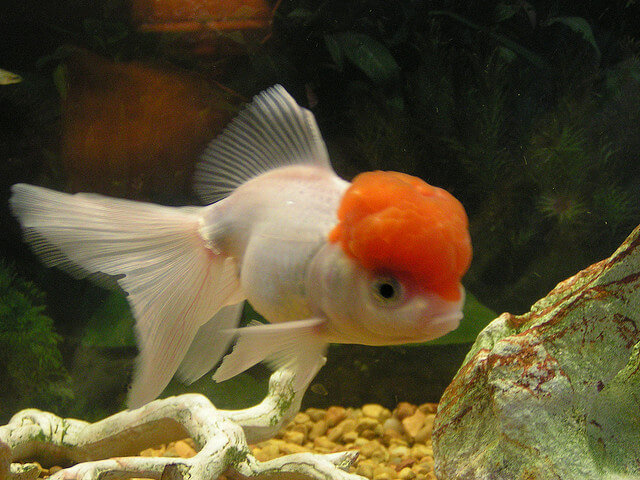
The Oranda Goldfish assortment is one of the fancier sorts of goldfish, making orandas one of the more troublesome extravagant goldfish breeds to deal with. They don't do well in waters with a temperature under 65 degrees which doesn't make them appropriate for your open air goldfish lake. It is ideal to put them in your goldfish aquarium with other sluggish extravagant varieties and a couple of amphibian plants. Because of its body shape, oranda goldfish are sluggish and ought to be feed a decent eating regimen to hold it back from having swim bladder or clogging issues. Rearing the oranda goldfish is another test for goldfish raisers. It is hard to decide the sex of orandas out of mating season yet ordinarily, guys are more modest and slenderer than females. During mating season, it is not difficult to sex them; guys produce white dabs on the hoods on their heads. (Try not to confuse this with goldfish ich.) If reproducers are effective in mating two oranda goldfish, it is uncommon to get excellent fry. A great oranda goldfish will have a short profound body, around 66% of its body length. The dorsal blade ought to be up high on its body similar as the ryukin goldfish. Any remaining blades ought to be long streaming and combined. The caudal ought to be partitioned and stream smoothly like the veiltail goldfish and have marginally squared following edges. Contingent upon which geological area the oranda was reared, its caudal tail will appear to be unique. For showing purposes, the caudal tail ought to be profoundly forked in the far east, however focuses are deducted for this in the west. An oranda goldfish is effectively unmistakable by its delicate mole like hood cover around its head. As they develop these hoods ought to create around its head and face. Some orandas will foster more and some probably won't foster any. A decent hood will have chunks of comparable size that cover the whole head back to its gills. The shades of the oranda goldfish are changed: metallic, strong (self-hued), different shadings (variegated) or calico. The redcap oranda goldfish ought to have a dark red hood and a silver body. Different tones incorporate dark, blue, chocolate, reds, and silvers.
Pearlscale
The pearlscale goldfish with its round body shape and arch like scales containing calcium carbonate, appears as though a golf ball. The calcium carbonate in the scales makes an example of little pearl-shaded vaults pushing through the skin of these goldfish types. It's what one may envision a goldfish would look like on the off chance that it gulped down a golf ball. The little pointed head containing a little mouth isn't garish and just makes the body of the pearlscale goldfish stand apart significantly more like the most recognizable component.
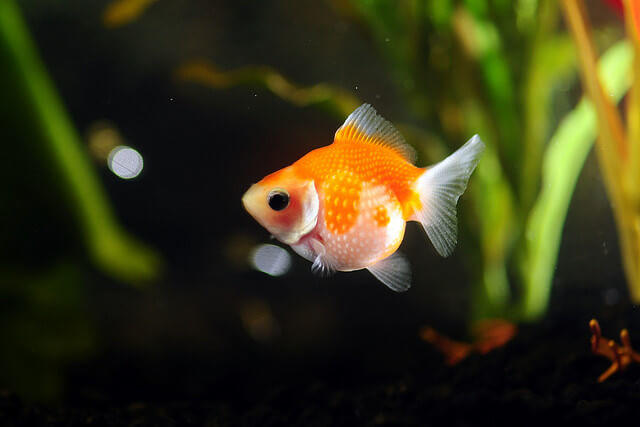 The single dorsal blade stands erect, start at the center of the back and stretches out right to the caudal peduncle. Any remaining blades are matched with adjusted finishes. The durable caudal balances of the pearlscale goldfish ought to be isolated and the projections somewhat forked. As the goldfish swims, the upper flaps on the caudal blades ought to put high and not drop down. The paerlscale goldfish arrives in a scope of tones including: metallic self-shaded and variegated (a strong shading or two unmistakable tones); calico which ought to be solid and adjusted. This solid reared can live in an outside goldfish lake yet are most appropriate for aquariums where their special highlights can truly be put in plain view.
The single dorsal blade stands erect, start at the center of the back and stretches out right to the caudal peduncle. Any remaining blades are matched with adjusted finishes. The durable caudal balances of the pearlscale goldfish ought to be isolated and the projections somewhat forked. As the goldfish swims, the upper flaps on the caudal blades ought to put high and not drop down. The paerlscale goldfish arrives in a scope of tones including: metallic self-shaded and variegated (a strong shading or two unmistakable tones); calico which ought to be solid and adjusted. This solid reared can live in an outside goldfish lake yet are most appropriate for aquariums where their special highlights can truly be put in plain view.
Hama Nishiki Goldfish
A cross reared between the pearlscale and the oranda. This goldfish reared looks a ton like the pearlscale, yet its blades are somewhat more, and it has a little wen hood cover on top of its face that it gets from the oranda. It additionally becomes marginally bigger than the pearlscale.
Ranchu
A ranchu goldfish is a full-bodied extravagant goldfish that comes up short on a dorsal balance and has wen hood cover similar as the oranda. The rear of the ranchu ought to have an articulated vertical curve where it bends forcefully downwards at the peduncle and caudal balances. This bend coordinates the pair of partitioned caudal blades downwards. The ideal point of the back bend and the course of the upper flaps of the caudal blades ought to be 90*.
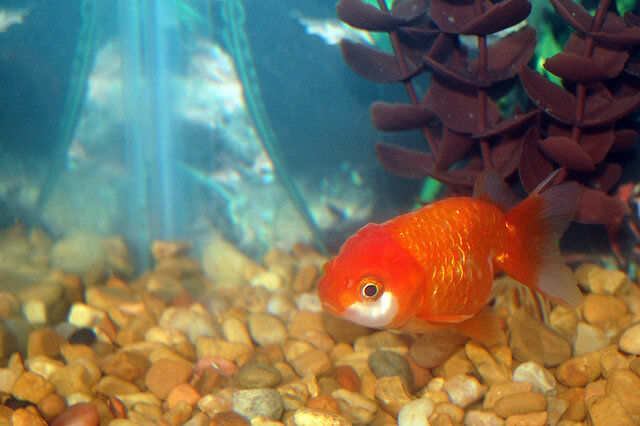 Perhaps the most clear highlights or scarcity in that department on a ranchu goldfish is the shortfall of the dorsal blade. A show quality example ought to have a clean angled back; there ought to be no indication of a dorsal balance, regardless of whether that be a knock or misery where the dorsal blade may have developed. The ranchu's wen hood cover ought to be bigger than that of the oranda. It should cover the whole head and face however not the eyes. A full wen hood cover can likewise cover the cheeks and gill covers and look like the mane of a lion. The Chinese variant of the ranchu is known as the lionhead for this reason.The ranchu goldfish from Japan and the lionhead goldfish from China are essentially similar variety with just minor contrasts for all intents and purposes. The rear of the lionhead goldfish type comes up short on a genuine curve and the bended peduncle is nonexistent. This permits the caudal balances to be more upstanding as opposed to being pointed downwards. A ranchu goldfish can be a metallic self-shaded orange, red-and-dark or a variegated various shading, normally red and white. There are red-and-white nacreous assortments that give it a mother of pearl tone called 'sakura nishiki' and there likewise calico nacreous shaded ranchu goldfish that are called 'edo nishiki'.
Perhaps the most clear highlights or scarcity in that department on a ranchu goldfish is the shortfall of the dorsal blade. A show quality example ought to have a clean angled back; there ought to be no indication of a dorsal balance, regardless of whether that be a knock or misery where the dorsal blade may have developed. The ranchu's wen hood cover ought to be bigger than that of the oranda. It should cover the whole head and face however not the eyes. A full wen hood cover can likewise cover the cheeks and gill covers and look like the mane of a lion. The Chinese variant of the ranchu is known as the lionhead for this reason.The ranchu goldfish from Japan and the lionhead goldfish from China are essentially similar variety with just minor contrasts for all intents and purposes. The rear of the lionhead goldfish type comes up short on a genuine curve and the bended peduncle is nonexistent. This permits the caudal balances to be more upstanding as opposed to being pointed downwards. A ranchu goldfish can be a metallic self-shaded orange, red-and-dark or a variegated various shading, normally red and white. There are red-and-white nacreous assortments that give it a mother of pearl tone called 'sakura nishiki' and there likewise calico nacreous shaded ranchu goldfish that are called 'edo nishiki'.
Pompon
The pompon goldfish is named after its most clear component, its meaty lobed nasal septa that look like pompons. These developments are associated with the goldfish's nasal septum and go about as sensors for smelling airborne synthetics and scents. At the point when completely created, the pompon flaps can hang down into the mouth of the goldfish yet in a quality example the pompon projections ought not hang down into the mouth. They ought to have a strong uniform development and be round fit. The body of a genuine pompon goldfish should resemble the group of ranchu types without a dorsal balance. There are anyway breeds that have a dorsal blade or give indications of a wen head cover. Pompon goldfish come in metallic and calico tones. Pompon goldfish are most appropriate for goldfish aquariums with water no colder than 55*F and ought not be set in an open air lake. Tank mates ought to just incorporate other sensitive and sluggish varieties like the telescope, oranda, bubble eye, or divine.
Air pocket Eye The air pocket eye goldfish has a comparable body shape, balances, and up pointing eyes as the heavenly does, yet it likewise has two liquid filled pocket of skin on its cheeks. An excellent example will have two similarly created pockets that sit directly underneath its eyes. As an air pocket eye goldfish swims and shifts course, its pockets will ricochet around and play get up to speed to the last move. The shadings an air pocket eye goldfish comes in are metallic self-hued, variegated, or calico.
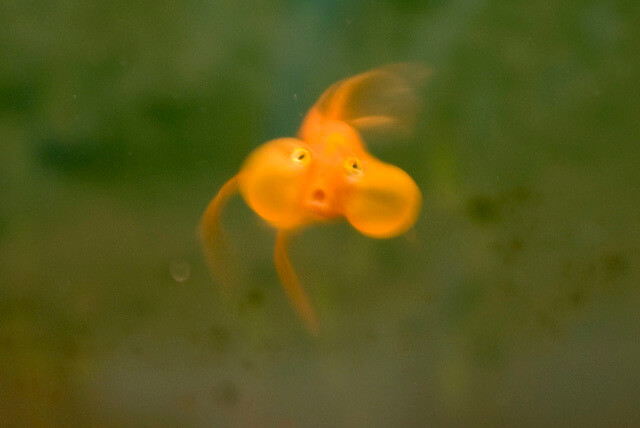
The slim skin that makes up a pocket is sensitive and requires unique consideration to guarantee it isn't harmed. Extensive idea ought to be placed into what kinds of substrate, aquarium enrichments, aquarium channels, lights and tank mates the air pocket eye goldfish's tank is loaded up with. With the presence of these pockets, up pointing eyes and alongside the absence of a dorsal balance, makes the air pocket eye goldfish a sluggish swimmer with helpless visual perception. Keep away from any aquarium design or substrate that contains sharp edges. Spot any air bubblers in a corner and far removed of where the air pocket eye goldfish swims. Pick a channel that doesn't have a solid admission or one that makes a solid current. Purchase low wattage aquarium lights. Just spot an air pocket eye goldfish in with other helpless seeing and moderate swimming goldfish breeds like the divine, pompon, ranchu or telescope.
Celestial
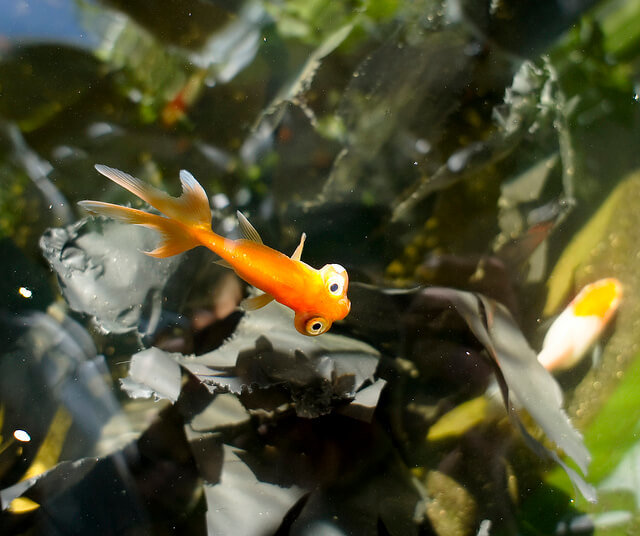 This little and fragile extravagant reproduced of goldfish has an exceptional element that needs extraordinary consideration to guarantee the goldfish's wellbeing, making it not appropriate for the amateur goldfish specialist. The eyes of the heavenly goldfish are jutting and set to consistently confront upwards. This element implies the heavenly goldfish ought not be in a tank with any enrichment that can scratch or jab its eyes. The goldfish tank ought not have a brilliant light since the heavenly goldfish is continually turning upward while very still. The divine goldfish comes up short on a dorsal balance and when it swims it pushes its head descending to see straight ahead. This lifts its body and caudal blades upwards, making it a lethargic swimmer and not appropriate for a tank with a water momentum. Tank mates ought to just incorporate other divine goldfish, bubble eyes, pompons or telescopes.
This little and fragile extravagant reproduced of goldfish has an exceptional element that needs extraordinary consideration to guarantee the goldfish's wellbeing, making it not appropriate for the amateur goldfish specialist. The eyes of the heavenly goldfish are jutting and set to consistently confront upwards. This element implies the heavenly goldfish ought not be in a tank with any enrichment that can scratch or jab its eyes. The goldfish tank ought not have a brilliant light since the heavenly goldfish is continually turning upward while very still. The divine goldfish comes up short on a dorsal balance and when it swims it pushes its head descending to see straight ahead. This lifts its body and caudal blades upwards, making it a lethargic swimmer and not appropriate for a tank with a water momentum. Tank mates ought to just incorporate other divine goldfish, bubble eyes, pompons or telescopes.

No comments:
Post a Comment